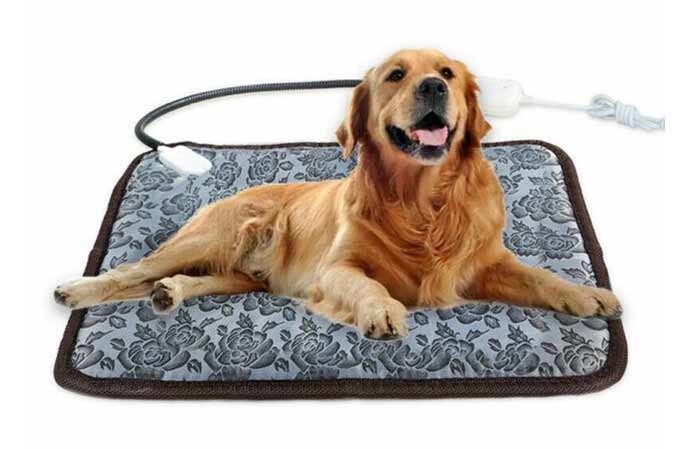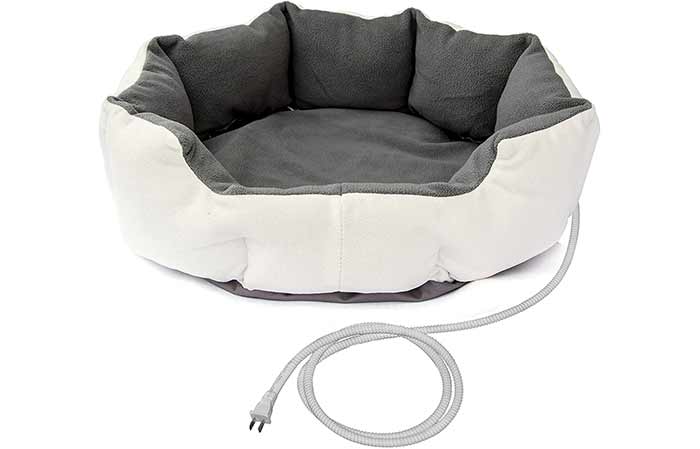During the cold season (winter) you wonder if your pet is warm enough, right? While the heating pads/ beds are used to keep your dog or cat warm, they also offer other benefits you could find vital to your pet. Including offering support to senior dogs.
So, are heating pads safe for cats and dogs? Yes, the heated pads are safe to use for your pet. However, there are risks involved especially with the electrical heating pads. Your pet risks electrocution, overheating, among other concerns.
If you’d like to know more about these heated pads then read the text below as it explains all about the pet heating beds in great detail.
What are Heating Pads and Beds and What is Their Role?
Heating pads are soft cushions made of durable material such as mylar, used to transmit heat and control the temperature of your pet.

Heating beds are similar to pads but slightly bigger and more engulfed like an actual bed. Either way, they both use the same mechanisms to offer warmth and comfort to your cat or dog.

Besides the obvious reason to offer warmth to your pet, the heating pads have other responsibilities. These include;
- Offering bone support to seniors/ aging pets.
- Therapy solutions to ailing pets. The pads have been known to aid with dogs that have arthritis.
- Comfort to pets of all ages and breeds.
These heating pads come in three types, all of which use different mechanisms to attract and maintain heat. The three modes included;
- Electric heating pads
- Microwaveable pads
- Self-heating/ thermal beds
Electric Pet Heating Pads
As the name suggests, these heating beds use electricity to generate heat onto the pad which then transfers the heat to the pet.
Similar to an electric blanket, the pad has to be connected to a power source/ socket where electric currents pass through the interior of the bed, generating warmth.
They are the best selection for your pet since it has thermal regulators, however, if your dog loves to chew in cable there are significant risks involved.
If you choose this option, ensure you adhere to certain security measures such as investing in a chew-proof cable as well as a waterproof membrane that will protect the electrical components.
Microwaveable Heating Pads
Next up is the microwaveable heating pad that’s filled with gel or any other material that can hold up the heat for long hours. All you need to do is warm the pad in the microwave for some time and lay it down for you let to enjoy.
This type also has considerable risks including overheating. It’s essential that you test the temperature of the pad before laying it for the pet to use. Use your skin to test (the most vulnerable spot; elbow or upper hand). Alternatively, add an extra cushion on top of the pad to add a layer of security.
The greatest advantage of microwaveable pads is that is very cost-friendly. However, the pads aren’t worth it if you have a large pet nor will the gel hold up heat throughout the entire night.
Self-Warming Pads/ Thermal Pet Beds
Last, but not least, the thermal warming pads. These type doesn’t require electricity or other artificial heating agents. Instead, they solely rely on the pet’s warmth to keep itself warm.
How?
Well, the pads have a thermal filling/ heat reflective material such as mylar that will reflect the pet’s body heat back into the pad. This way, all the risks of overheating are mitigated.
The warmth will remain overnight as the pet remains warm and snug all through the night.
With no electrical wiring to be concerned with and no wire to chew from; these pads are the safest and easiest to use.
What are the Safety Concerns Associated with Heating Pads?
First and foremost, it’s vital that you know before you buy a heating pad, check the product’s certification.
Products from the USA and Canada should be certified by MET laboratories. In case it’s from another country, do also check if the pad is tested and certified by their local/ national electrical testing laboratory.
That being said, let’s now have a look at what safety issues these heating beds have.
Electrocution
Several dogs have a propensity to chewing on electrical components such as wires and cables.
As hard taped or wrapped as the electrical cords may be, the constant running by the dog will soon give causing a risk of electrocution.
Hence, the safest measures you could take are to ensure the product is chew resistant not chew proof.
Worst case scenario, even if your pet isn’t electrocuted, the wires remain exposed, which could then cause a fire hazard. You don’t want to see the end of that!
Overheating
You know how uncomfortable you feel when the air temperatures are just too hot? The sweating, the risk of heat burns, feeling uneasy? Well, not only is it unfriendly to your pet, it’s unsafe.
Heat buildup occurs when the temperatures exceed the normal body heat, which could then affect the skin on your pet.
You can know if the pet is experiencing overheating when they fidget every now and then, readjusting themselves, or they completely leave the pad.
Furthermore, as unsafe as it is for your pet, it’s worse for an immobile pet that can’t be able to reposition themselves since they risk damage to their skin even more.
Additionally, watch for dog panting which signifies the canine is uncomfortable and/ or overheating.
Strangulation
By definition, this is when a wire, rope, or cord passes through your neck causing you to lack air or free passage of air into the lungs. In this case, the long cords from an electric heating bed can tangle up the pet causing strangulation.
Unfortunately, this has been a silent killer since cats also have a tendency of playing with the cord, which in turn could choke them and kill them.
Intestinal Blockage
Again with the cats, they are known to nibble on just about anything. Hence, if your cat eats on the wires, piece of cover cloth, or plastic; it could risk intestinal blockage, which means surgery or immediate medical attention. If the blockage isn’t treated soon enough, it’ll be toxic to the cat leading even to death.
Are They Safe or Not?
Ideally, heating pads are safe because they are designed for pets. Many will have additional features such as auto-off settings so you don’t have to constantly check on it, but primarily, major manufacturers will put safety measures in place. For example;
- A thermostat. This is an essential element added to the bed that ensures it doesn’t overheat. The mat will reach a maximum temperature of between 105 to 110 °F.
- Anti – chew cables. Electrical cords will have a protective cover that’s tough and resistant to prevent your pet from chewing into the live cable.
- Fire retardant materials. You’ve read about the risk of a fire hazard. The best way to prevent this is to have a fire retardant material as the cover so as to ensure sparks of electricity from the live wire doesn’t inflame the pad.
- Low voltage options. Heating mats come in low voltages that pass through an adaptor, which is an armored section of the cable. This way the risk of electrocution is reduced significantly.
These should ensure safety as you use the heating pads.
What Alternatives are There?
Despite the additional features added to safeguard you as the consumer, some of you may be a little skeptical. Hence, there are several alternatives you can use. Easy homemade warming kits that are safe, cost-efficient, and simple to make.
Microwaved Towels
Instead of buying a heating mat for the sole purpose of warming in the microwave, customize the mat, and use a towel instead. Here’s how;
Requirements
- A hand towel
- Sealable bags
- Microwave and electricity
Method
- Rinse the hand towel in water and wring out excess water. Ensure the towel is damp, not wet
- Place it in the sealable bag/ ziplock bag and leave it open for now.
- Place in the microwave and heat for two to three minutes.
- Remove and seal the bag to retain as much steam and heat from the towel.
- Place it in your pet’s bed add a cushion on top to avoid direct contact with the skin.
Hot Water Bottle
Those with heavy menstrual cramps will attract to this method. Simply add hot water to a hot water bottle add cover with a cloth, cushion, or blanket. Let the pet use it overnight.
Heated Rice in Socks
Finally, one of the most common DIY heating pad methods is heating rice in socks using the microwave. The method is very similar to the first option where you add rice to sock and microwave for two minutes. The effects will be just as similar.
However, this particular method works best for targeted pain areas. For example, if your dog has joint pains or needs therapy for a certain body section that underwent surgery; this is the best way to do it. You’ll simply add the heated socks over the section and that’s it.






